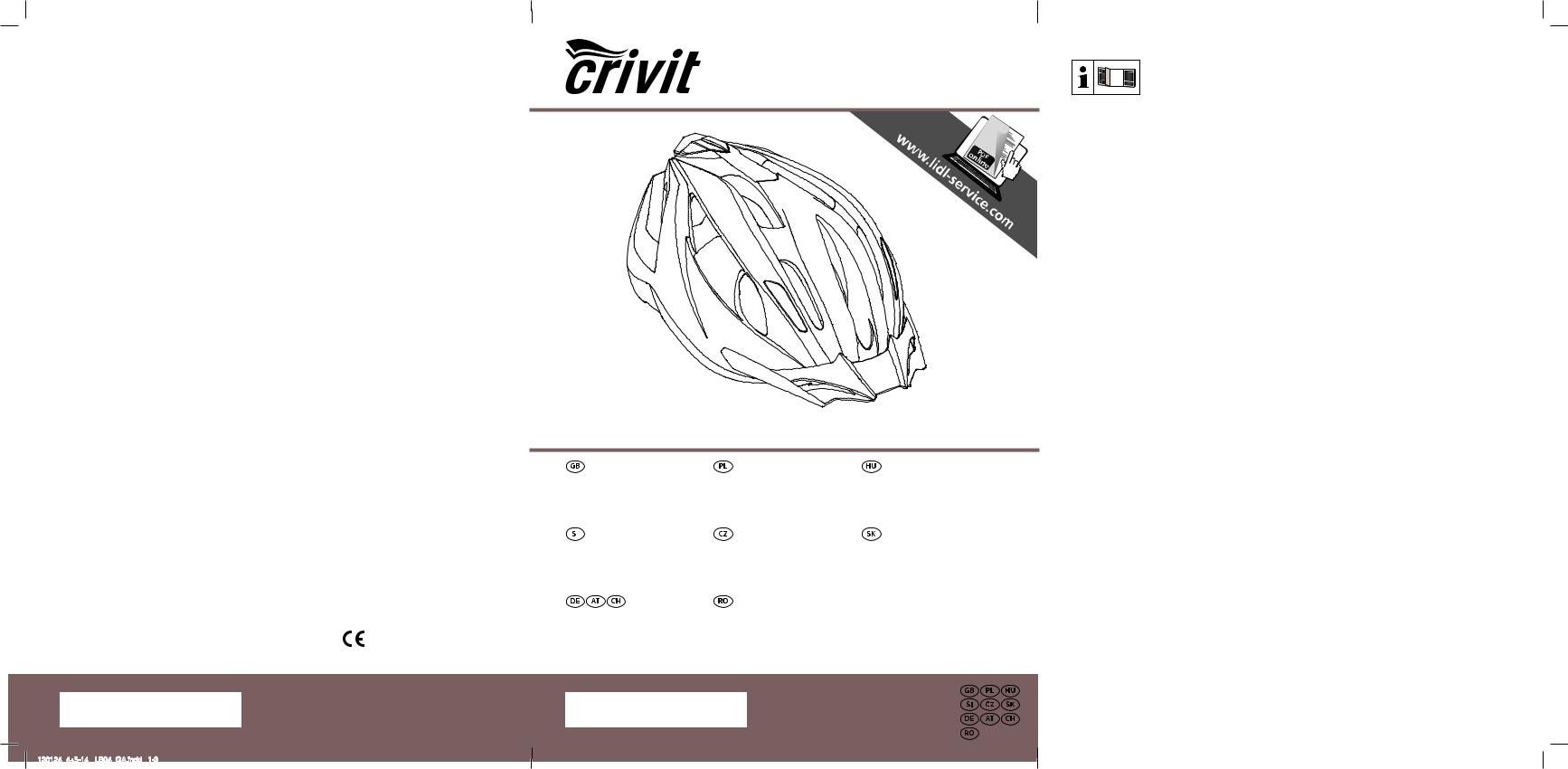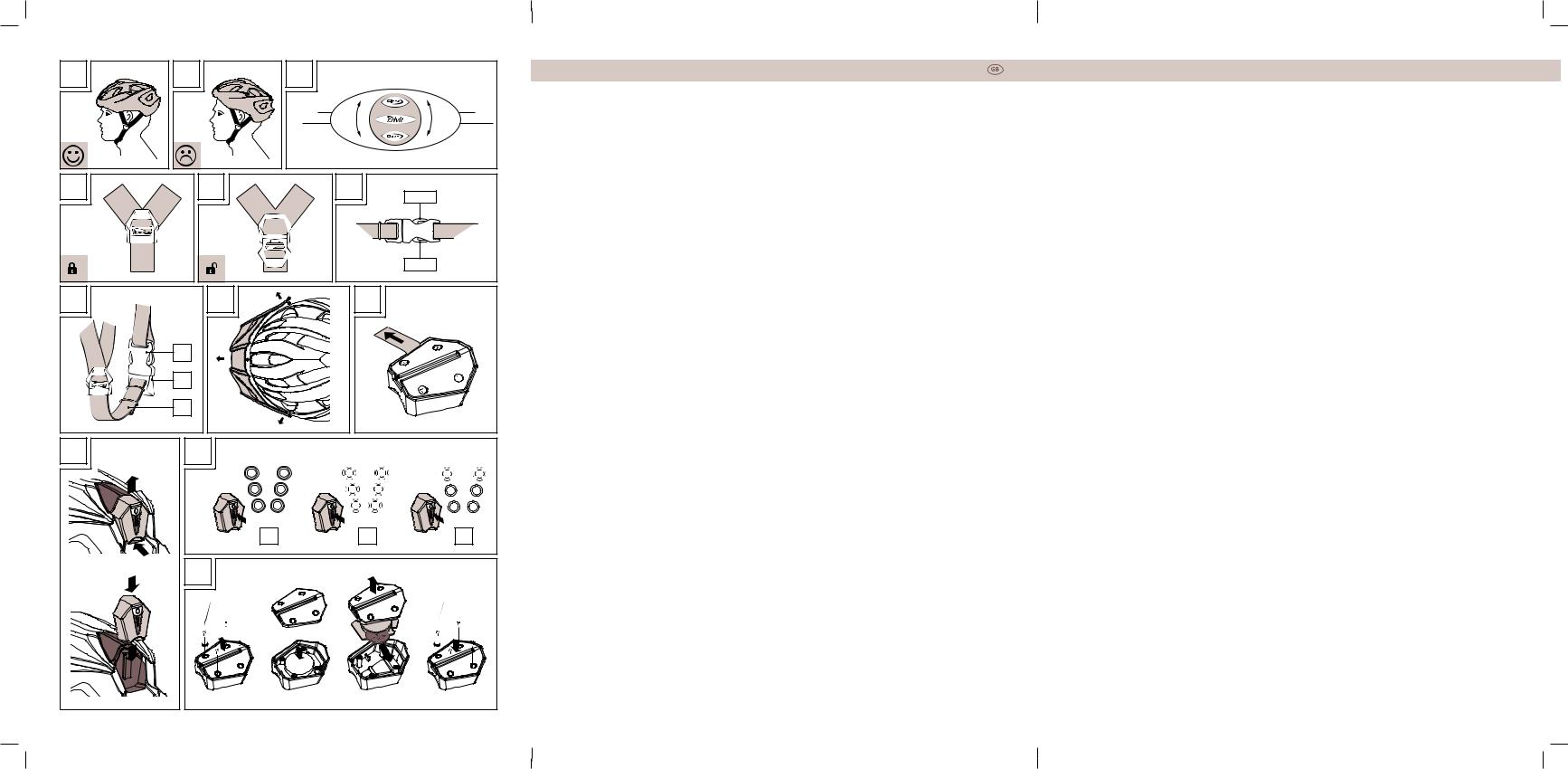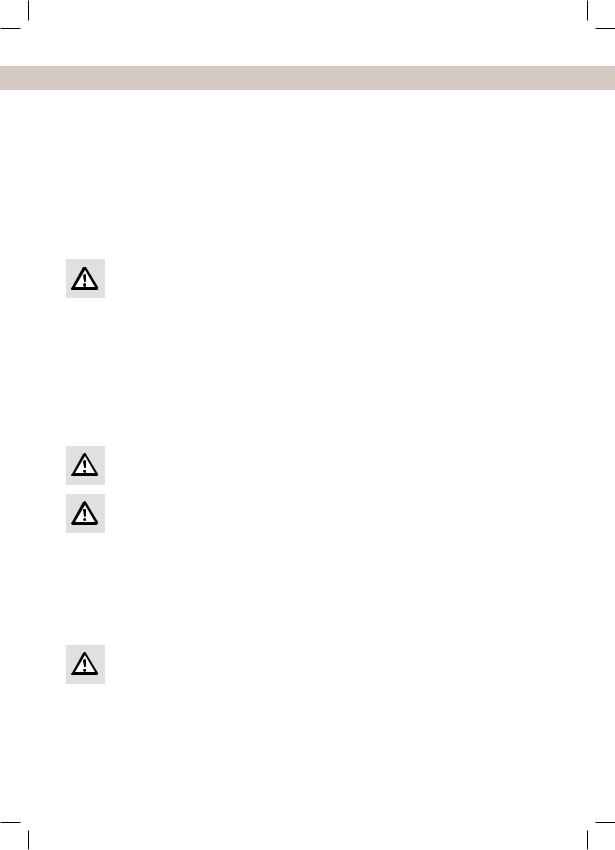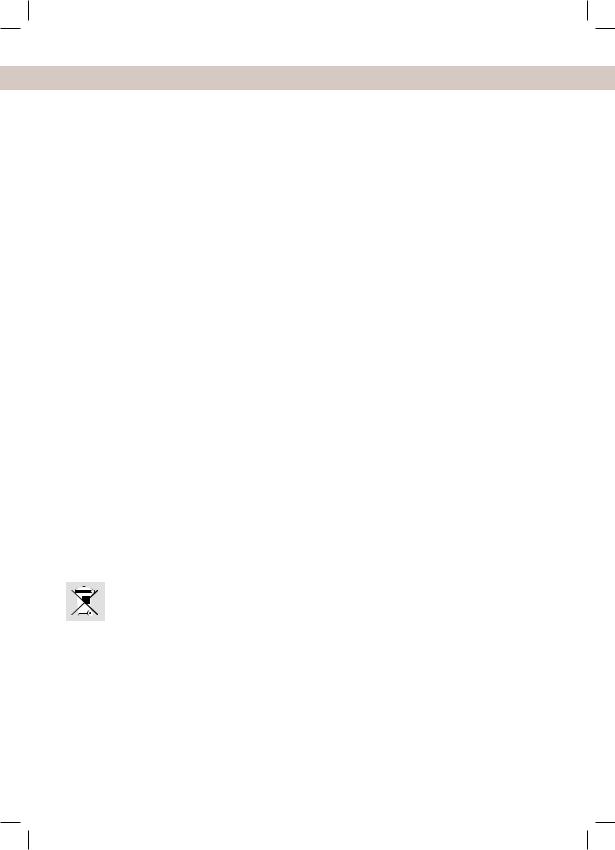Crivit SP - 33 User Manual [en, pl, cs, de]

SPEQ GmbH |
TÜV Süd Product Service GmbH |
|
Tannbachstraße 10 |
Ridlerstr. 65 |
|
D-73635 Steinenberg |
D-80339 München |
|
Hotline + 800 30 777 999 |
Kenn-Nr. 0123 |
|
e-mail: |
info@speq.de |
|
web: |
www.speq.de |
|
Last update ∙ Stan informacji ∙ Az információk aktualitása ∙ |
PSA 89/686/EWG |
|
Stanje informacij ∙ Stav informací ∙ Stav informácií ∙ |
DIN EN 1078 |
|
Stand der Information: 03/2013 |
|
|
IAN 89264 4
130124_4+5-14_ LB04_GA.indd 1-3
BICYCLE HELMET SP - 33/ LED REAR LIGHT SP - 2
BICYCLE HELMET SP-33/ |
KASK ROWEROWY SP-33/ |
KERÉKPÁROS BUKÓSISAK |
|
LED REAR LIGHT SP-2 |
LAMPKA LED ŚWIATŁA |
SP-33/ LED HÁTSÓ LÁMPA |
|
owner´s manual |
WSTECZNEGO SP-2 |
SP-2 |
|
|
|
Instrukcja u˝ytkowania |
Kezelési utmutató |
|
|
|
|
|
|
|
|
KOLESARSKA ČELADA SP-33/ |
CYKLISTICKÁ HELMA SP-33/ |
CYKLISTICKÁ HELMA SP-33/ |
|
LED ZADNJA LUČ SP-2 |
LED ZADNÍ SVĚTLO SP-2 |
POKYNY PRE UŽÍVAT EĽOV |
|
Navodila za uporabo |
Navod k použiti |
SP-2 |
|
|
|
|
Navod aa použitie |
FAHRRADHELM SP-33/
LED RÜCKLICHT SP-2
Gebrauchsanleitung
CASCĂ DE BICICLETĂ SP-33 / LUMINĂ DE CONTROL CU SP-2
Modul de utilizare
IAN 89264
GB |
Owner´s Manual |
04 - 08 |
|
|
|
PL |
Instrukcja u˝ytkowania |
09 - 13 |
|
|
|
HU |
Kezelési utmutató |
14 - 18 |
|
|
|
SI |
Navodila za uporabo |
19 - 23 |
|
|
|
CZ |
Navod k použiti |
24 - 28 |
|
|
|
SK |
Navod aa použitie |
29 - 33 |
|
|
|
DT / AT / CH |
Gebrauchsanleitung |
34 - 38 |
|
|
|
RO |
Modul de utilizare |
39 - 43 |
08.03.2013 11:36:49

A |
B |
C |
|
D |
E |
F |
Press |
|
|
|
|
|
|
Press |
G |
H |
I |
|
|
1 |
|
|
|
2 |
|
|
|
3 |
|
|
J |
K |
|
|
|
1x |
2x |
3x |
|
L |
|
|
130124_4+5-14_ LB04_GA.indd 4-5 |
|
|
|
|
|
Bicycle helmet SP - 33 |
Bicycle helmet SP - 33 |
04 |
|
Safety information |
05 |
|
|
|
|
User information |
05 |
|
|
|
|
1. |
The correct helmet position |
05 |
|
|
|
2. |
Adjusting the single-hand twisting fastener |
05 |
|
|
|
3. |
Adjusting the strap divider |
06 |
|
|
|
4. |
Adjusting the chin strap |
06 |
|
|
|
5. |
Visor |
06 |
|
|
|
6. |
Cleaning and care |
06 |
|
|
|
7. |
Disposal |
06 |
|
|
|
LED - Rear light SP - 2 |
07 |
|
Safety information |
07 |
|
|
|
|
User information |
07 |
|
|
|
|
1. |
Before the first use |
07 |
|
|
|
2. |
Removal and attachment of the tail light |
08 |
|
|
|
3. |
Functions |
08 |
|
|
|
4. |
Changing the batteries |
08 |
|
|
|
5. |
Cleaning and care |
08 |
|
|
|
6. |
Disposal |
08 |
|
|
|
BICYCLE HELMET SP - 33
Dear Customer!
We are pleased that you have decided to purchase one of our high-quality products, which are manufactured and certified in strict adherence to the currently valid safety standards.
4
NOTES
________________________________________________________________________________
________________________________________________________________________________
________________________________________________________________________________
________________________________________________________________________________
________________________________________________________________________________
________________________________________________________________________________
________________________________________________________________________________
________________________________________________________________________________
________________________________________________________________________________
________________________________________________________________________________
________________________________________________________________________________
45
08.03.2013 11:36:50

Bicycle helmet SP - 33 
Safety information
•Parents should make sure that their children take the helmet off before entering a children‘s playground. The helmets must not be used by children when climbing or playing other games in which there is a danger of strangulation !!!
•Your helmet was specially designed for protection during cycling 1, skateboarding 3, roller-skating 2 and riding a scooter 4. It must not be used for other types of sport or for motorcycling 5.
•Please note that the helmet can only provide protection if it fits correctly. Please ensure you try out a range of different sizes before buying.
•Please be aware that despite correct adjustment your helmet cannot always protect you from all injuries.
•The helmet should be checked for visible deficiencies at regular intervals.
•The helmet must be replaced after every hard knock, impact or deep scratch, because these cause it to lose its protective effect.
•Any adjustment to or removal of the original parts of the helmet can extremely impair its protective function. The helmet may not be altered in order to make additions in a way not recommended by the manufacturer.
•Clean the inner padding with lukewarm water and mild soap and then let it air dry
•High temperatures, from as low as 60° C, can seriously damage the helmet. Uneven helmet surfaces and the formation of small blisters are signs of such damage. Do not store behind panes of glass, e.g. in the car or close to sources of heat or warmth.
User information
1.The correct helmet position
•The helmet must always be levelly horizontal on your head.(Fig. A)
•If the helmet is too far forward, it can impair your vision.
•If the helmet is too far back, your forehead is not sufficiently protected. (Fig. B)
2.Adjusting the single-hand twisting fastener
The integrated size-adjusting system can be adjusted using a turning knob at the back of one’s head (Fig. C):
•smaller = twist clockwise
•bigger = twist anti-clockwise
5
130124_4+5-14_ LB04_GA.indd 5 |
12.03.2013 10:53:43 |

 Bicycle helmet SP - 33
Bicycle helmet SP - 33
3.Adjusting the strap divider
•Open the strap divider (Fig. D)
•The strap divider must be positioned in such a way, that the straps are taut but comfortable. The strap divider must be below the ear, and the straps must not cover the ears.
•Close the strap divider (Fig. E)
An open strap divider can lead to slipping of the helmet in the event of an accident and thus to a loss of protection!!!
4.Adjusting the chin strap
•The chin strap (Fig. G.3) has been adjusted correctly if you feel slight pressure when you open your mouth.
•If the chin strap (Fig. G.3) is too loose it must be pulled tight using the winding (Fig. G.2) on the fastener (Fig. G.1).
•If the chin strap (Fig. G.3) is too tight it must be loosened also using the winding (Fig. G.2) on the fastener (Fig. G.1).
Please note that you must always make sure that the fastener is closed before you ride !!! (Fig. F)
Please be aware that the helmet can only protect if it fits properly.
Please try out different sizes and choose the one in which the helmet fits comfortably and sits firmly upon your head.
5.Visor
•Carefully pull out the pins on the visor from the pin holes on the helmet shell to remove the visor (Fig. H).
Attention: The pin holes on the helmet can expand through excessive use. In this case, the visor may no longer be used.
6.Cleaning and care
•All chemicals, paints and stickers can seriously impair the protective effect of the helmet.
•Only clean your helmet with lukewarm water, mild soap and a soft cloth.
•After every use, leave your helmet exposed to the air in order for it to dry.
7.Disposal
Please contact your local waste disposal company for the disposal of the helmet.
6
130124_4+5-14_ LB04_GA.indd 6 |
08.03.2013 11:36:23 |

LED-rear light SP - 2 
LED-REAR LIGHT SP-2
Safety information
•The LED rear light is not a substitute for the light equipment stipulated by the German standard StVZO (§ 67).
•When used correctly, the LED rear light gives better visibility. The LED backlight should not be used during rainy weather. It cannot be guaranteed to work if it gets wet.
•Please only use the LED rear light together with this cycle helmet and always put it onto the rotating wheel of the size-adjustment system.
•The LED rear light is only intended for personal use.
•Please make sure that, during use, the LED cannot be covered or obscured by collars, rucksacks or movements of the head.
•The LED light can under certain circumstances come loose without this being noticed, if it becomes caught on jackets, rucksacks or other objects.
•Please be aware that the battery of the LED light can fall out or become flat. Therefore, check the light regularly for proper functioning.
•The batteries must not be exposed to excessive heat such as sunshine, fire or the like. In the event that the batteries are
•incorrectly changed there exists the risk of explosion. Only replace the batteries with the same or an equivalent battery type.
•Parents should ensure that their child also checks to make sure that the LED backlight is working on a regular basis.
•The LED rear light is not suitable for use by children under 4 years of age.
•The LED rear light is not a toy and its use by children is only permitted if they are under the supervision of adults.
•The changing of batteries must only be carried out by adults.
•If the battery leaks, avoid any contact with the skin as this can lead to skin irritation.
•Leaking batteries must be disposed of immediately
User information
1.Before the first use
•Take the tail light off the helmet (fig. J). Before the first use, remove the safety strips from the reverse of the LED tail light. (Fig. I).
7
130124_4+5-14_ LB04_GA.indd 7 |
08.03.2013 11:36:24 |

 LED-rear light SP - 2
LED-rear light SP - 2
2.Removal and attachment of the tail light
• To remove the LED tail light, push this upwards out of the holder (Fig. J).
• To attach the LED tail light, push this again into the holder provided (Fig. J).
3. Functions
The LED rear light has three different functions, each of which can be used as desired (Fig. K).
•Press x1: continuous light,
•press x2: flashing light,
•press x3: colour chaser,
•press x4: light off.
4.Changing the batteries
The LED tail light comes equipped with a CR 2025 (3V) battery.
•To change this battery, unscrew the four screws on the reverse of the light with a small screwdriver.
•Then lift the cover, exchange the batteries and put the cover back on. Ensure that the battery polarity is correct (Fig. L)
•Now fasten the cover again with the four screws (Fig. L).
Battery type: CR 2025 (3V)
5. Cleaning and care
The housing of the LED rear light can be cleaned with a damp cloth.
6. Disposal
Please do not dispose of flat batteries via the household waste, but instead use the collecting container intended for this purpose.
8
130124_4+5-14_ LB04_GA.indd 8 |
08.03.2013 11:36:24 |

Kask rowerowy SP - 33 
Kask rowerowy SP - 33 |
09 |
|
Wskazówki dotyczące bezpieczeństwa |
10 |
|
|
|
|
Wskazówki dotyczące użytkowania |
10 |
|
|
|
|
1. |
Prawidłowe ułożenie kasku |
10 |
|
|
|
2. |
Ustawienie zamknięcia obrotowego obsługiwanego jedną RĘKĄ |
10 |
|
|
|
3. |
Regulacja rozdzielacza paska |
11 |
|
|
|
4. |
Regulac ja paska podbródkowe go |
11 |
|
|
|
5. |
Wizjer |
11 |
|
|
|
6. |
Czyszczenie |
11 |
|
|
|
7. |
Utylizacja |
12 |
|
|
|
Lampka LED światła wstecznego SP - 2 |
12 |
|
Wskazówki dotyczące bezpieczeństwa |
12 |
|
|
|
|
Wskazówki dotyczące użytkowania |
13 |
|
|
|
|
1. |
Przed pierwszym użytkowaniem |
13 |
|
|
|
2. |
Zdejmowanie i zakładanie tylnego światła |
13 |
|
|
|
3. |
Funkcje |
13 |
|
|
|
4. |
Wymiana baterii |
13 |
|
|
|
5. |
Czyszczenie |
13 |
|
|
|
6. |
Utylizacja |
13 |
|
|
|
KASK ROWEROWY SP - 33
Szanowni Klienci!
Cieszymy się bardzo, iż zdecydowaliście się Państwo na zakup naszych wysokiej jakości produktów wytwarzanych i certyfikowanych ściśle według aktualnie obowiązujących norm bezpieczeństwa.
9
130124_4+5-14_ LB04_GA.indd 9 |
08.03.2013 11:36:24 |

 Kask rowerowy SP - 33
Kask rowerowy SP - 33
Wskazówki dotyczące bezpieczeństwa
•Drodzy Rodzice, Prosimy zwracać uwagę na to, by Wasze dzieci zawsze zdejmowały kask przed wejściem na plac zabaw. Dzieci nie mogą mieć założonych kasków podczas wspinania się lub innych zabaw, podczas których istnieje niebezpieczeństwo uduszenia!!!
•Kask dla Państwa zaprojektowano tak, aby stanowił ochronę podczas jazdy rowerem 1, jazdy na hulajnodze 3, jazdy na wrotkach 2 i jazdy na deskorolce 4. Nie wolno go używać do innych sportów lub do jazdy na motocyklu 5.
•Należy mieć na uwadze, że kask tylko wtedy stanowi ochronę, gdy jest dobrze dopasowany. Podczas jego kupowania koniecznie należy przymierzyć różne rozmiary.
•Prosimy pamiętać o tym, iż mimo prawidłowego ustawienia kask nie zawsze może chronić przed wszelkimi obrażeniami.
•Kask należy sprawdzać w regularnych odstępach czasu pod kątem widocznych wad.
•Po każdym mocnym zderzeniu, uderzeniu lub głębokim zadrapaniu kask należy wymienić, gdyż na skutek tego typu zdarzeń nie posiada już działania ochronnego.
•Wszelkie chemikalia, lakiery lub nalepki mogą poważnie zmniejszyć działanie ochronne kasku.
•Wyściółkę wewnętrzną oczyścić letnią wodą i delikatnym mydłem, a na stępnie wysuszyć na wolnym powietrzu.
•Wysokie temperatury, już powyżej 60° C, mogą prowadzić do poważnego uszkodzenia kasku. Nierówna powierzchnia kasku i tworzenie się pęcherzy są oznakami takiego właśnie uszkodzenia. Kasku nie należy przechowywać za szybami, np. w samochodzie lub w pobliżu źródeł gorąca lub ciepła.
•Odnośnie utylizacji kasku prosimy o nawiązanie kontaktu z lokalnym przedsiębiorstwem utylizującym odpady.
Wskazówki dotyczące użytkowania
1.Prawidłowe ułożenie kasku
•Kask winien być zawsze ułożony na głowie poziomo. (ilustr. A)
•Jeśli kask przechylony jest za bardzo do przodu, zasłania pole widzenia.
•Jeśli kask przechylony jest za bardzo do tyłu, czoło nie jest chronione wystarczająco dobrze (ilustr. B)
2.Ustawienie zamknięcia obrotowego obsługiwanego jedną RĘKĄ
Zintegrowany system regulacji rozmiaru można regulować bezstopniowo z tyłu głowy (ilustr. C):
10
130124_4+5-14_ LB04_GA.indd 10 |
08.03.2013 11:36:24 |

Kask rowerowy SP - 33 
•Mniejszy rozmiar = przekręcać w prawo
•Większy rozmiar = przekręcać w lewo
3.Regulacja rozdzielacza paska
•Otworzyć rozdzielacz paska (ilustr. D)
•Rozdzielacz paska ustawić tak, aby paski były napięte, ale nie uciskały. Rozdzielacz winien znajdować się poniżej uszu, paski nie mogą jednak zakrywać uszu.
•Zamknąć rozdzielacz paska (ilustr. E)
Nie zamknięty rozdzielacz paska w razie wypadku może prowadzić do przesunięcia kasku, a tym samym do utraty funkcji ochronnej!!!
4.Regulac ja paska podbródkowe go
•Pasek) podbródkowy (ilustr. G.3) jest wtedy należycie wyregulowany, gdy przy otwieraniu ust daje się odczuć lekki nacisk.
•Zbyt luźny pasek podbródkowy (ilustr. G.3) należy podciągnąć zapomocą zwoju na sprzączce (ilustr. G.1).
•Jeśli pasek podbródkowy (ilustr. G.3) jest za ciasny, należy gon poluzować również za pomocą zwoju paska na sprzączce (ilustr. G.1).
Prosimy pamiętać o zamknięciu sprzączki przed rozpoczęciem jazdy!!! (ilustr. F)
Prosimy pamiętać o tym, iż kask może chronić tylko wtedy, gdy jest prawidłowo dopasowany. Prosimy o wypróbowanie różnych rozmiarów i wybranie takiego, przy którym kask osadzony jest na głowie wygodnie i pewnie.
5.Wizjer
•W celu zdjęcia wizjera, należy ostrożnie wyjąć przetyczki wizjera z otworów przeznaczonych do zamocowania czaszy kasku (ilustr. H).
Uwaga: Otwory do zamocowania w kasku wskutek nadmiernego użytkowania mogą się rozszerzyć. W tym przypadku nie można już korzystać z wizjera.
6.Czyszczenie
•Zmiany lub usuwanie oryginalnych części kasku może wpłynąć bardzo negatywie na skuteczność ochrony. Kasku nie wolno zmieniać w takim celu, aby umieścić na nim dodatki, które przytwierdzane byłyby w sposób nie zalecony przez producenta.
11
130124_4+5-14_ LB04_GA.indd 11 |
08.03.2013 11:36:24 |

 Lampka LED światła wstecznego SP - 2
Lampka LED światła wstecznego SP - 2
•Kask należy czyścić wyłącznie ciepłą wodą, łagodnym mydłem i miękką szmatką.
•Po każdym użyciu kask należy osuszyć na powietrzu.
7.Utylizacja
•Odnośnie utylizacji kasku prosimy o nawiązanie kontaktu z lokalnym przedsiębiorstwem utylizującym odpady.
LAMPKA LED ŚWIATŁA WSTECZNEGO SP-2
Wskazówki dotyczące bezpieczeństwa
•Tylne światło LED nie zastępuje obowiązkowego zgodnie z niemieckimi przepisami StVZO (§67) oświetlenia rowerów.
•Tylne światło LED zapewnia w przypadku prawidłowego użytkowania lepszą widoczność na drodze. Nie używać tylnego światła w czasie deszczu, gdyż nie ma gwarancji jego działania w takich warunkach.
•Tylne światło LED należy stosować tylko z niniejszym kaskiem rowerowym, należy go zawsze nakładać na pokrętło regulacji systemu regulacji wielkości.
•Tylne światło LED jest zaprojektowane tylko na użytek prywatny.
•Proszę zwrócić uwagę, aby tylne światło LED podczas użytkowania nie było zasłonięte kołnierzem, plecakiem lub na skutek ruchów głowy.
•Światło LED może się w niezauważony sposób odczepić od kurtki, plecaka lub innych przedmiotów.
•Proszę pamiętać, że bateria tylnego światła LED może się wyczerpać. Dlatego też należy regularnie kontrolować prawidłowość działania urządzenia.
•Nie wolno wystawiać baterii na działanie nadmiernej temperatury, np. promieni słonecznych, ognia itp. W przypadku niewłaściwej wymiany baterii istnieje niebezpieczeństwo eksplozji. Baterie wolno wymieniać wyłącznie na baterie tego samego typu.
•Rodzice powinni zwracać uwagę na to, aby ich dziecko systematycznie kontrolowało działanie tylnego światła.
•Tylne światło LED nie jest przeznaczone dla dzieci poniżej 4 lat.
•Tylne światło LED nie jest zabawką i może być używane przez dzieci wyłącznie pod nadzorem osób dorosłych.
•Wymiana baterii może być wykonywana tylko przez osoby dorosłe.
•Należy unikać kontaktu baterii ze skórą, gdy z baterii wyciekł elektrolit. Taki kontakt powoduje podrażnienia skóry.
•Baterie, z których wyciekł elektrolit, należy natychmiast zutylizować.
12
130124_4+5-14_ LB04_GA.indd 12 |
08.03.2013 11:36:24 |

Lampka LED światła wstecznego SP - 2 
Wskazówki dotyczące użytkowania
1.Przed pierwszym użytkowaniem
•Zdjąć tylne światło z kasku (ilustr. J). Przed pierwszym użyciem należy zdjąć pasek bezpieczeństwa znajdujący się z tyłu światła tylnego LED (ilustr. I).
2.Zdejmowanie i zakładanie tylnego światła
•W celu zdjęcia tylnego światła LED należy je wysunąć w górę z uchwytu. (ilustr. J)
•W celu założenia należy ponownie wsunąć tylne światło LED w przeznaczony do tego celu uchwyt (ilustr. J).
3.Funkcje
Tylne światło LED posiada dwie różne funkcje, które mogą być stosowane w zależności od potrzeb (ilustr. K).
•1 x wciśnięcie: światło ciągłe,
•2 x wciśnięcie: światło migające;
•3 x wciśnięcie: światło kroczące,
•4 x wciśnięcie: światło wyłączone
4.Wymiana baterii
Tylne światło LED jest wyposażone przy zakupie baterią typu CR 2025 (3V).
•W celu wymiany tej baterii należy odkręcić za pomocą małego śrubokręta cztery śruby z tyłu obudowy światła.
•Następnie należy podnieść pokrywę, wymienić baterię i ponownie nałożyć pokrywę. Należy przestrzegać właściwej biegunowości baterii (rys. L)
• Teraz należy ponowie przymocować pokrywę za pomocą czterech śrub (ilustr. L).
Typ baterii: CR 2025 (3V)
5. Czyszczenie
Obudowę tylnego światła LED można wyczyścić wilgotną szmatką.
6. Utylizacja
Nie wolno wyrzucać baterii razem z odpadami domowymi, należy je włożyć do odpowiednich pojemników zbiorczych.
13
130124_4+5-14_ LB04_GA.indd 13 |
08.03.2013 11:36:24 |

 Kerékpáros bukósisak SP - 33
Kerékpáros bukósisak SP - 33
Kerékpáros bukósisak SP - 33 |
14 |
|
Biztonsági tudnivalók |
15 |
|
|
|
|
Használati útmutatások |
15 |
|
|
|
|
1. |
A bukósisk me gfelel ő el hel yez kedése |
15 |
|
|
|
2. |
Az egykezes nagyságállító rendszer beállítása |
15 |
|
|
|
3. |
Tartószíj elosztó beállítása |
16 |
|
|
|
4. |
Az állszíj beállítása |
16 |
|
|
|
5. |
Sisakrostély |
16 |
|
|
|
6. |
Tisztítás és gondozás |
16 |
|
|
|
7. |
Ártalmatlanítás |
17 |
|
|
|
LED hátsó lámpa SP - 2 |
17 |
|
Biztonsági tudnivalók |
17 |
|
|
|
|
Használati útmutatások |
18 |
|
|
|
|
8. |
Az első használat előtt |
18 |
|
|
|
9. |
Vegye le és tűzze fel a hátsó lámpát |
18 |
|
|
|
10. |
Funkciók |
18 |
|
|
|
11. |
Telepcsere |
18 |
|
|
|
12. |
Tisztítás és gondozás |
18 |
|
|
|
13. |
Ártalmatlanítás |
18 |
|
|
|
KERÉKPÁROS BUKÓSISAK SP - 33
Tisztelt Vásárló!
Örülünk, hogy kiváló minőségű termékünk megvétele mellett döntött, amely a jelenleg érvényes biztonságtechnikai szabványoknak megfelelően készült és az előírás szerinti minőségi tanúsítvánnyal rendelkezik.
14
130124_4+5-14_ LB04_GA.indd 14 |
08.03.2013 11:36:24 |

Kerékpáros bukósisak SP - 33 
Biztonsági tudnivalók
•A szülő ügyeljen rá, hogy gyermeke egy gyermekjátszótérbe való belépés előtt feltétlenül vegye fel a védősisakot. A bukósisakot nem használhatják a gyermekek mászásnál vagy más olyan játék alkalmával, ahol fennállhat a rögzítő szíj miatti fulladás veszélye!!!
•Az Ön bukósisakját speciálisan a kerékpározáskor 1, ugródeszkázáskor 3, görkorcsolyázáskor 2 és rollerezéskor 4 szükséges védelemhez fejlesztették ki. Másféle sporthoz vagy motorkerékpározáshoz 5 használni nem szabad.
•Kérjük annak figyelembe vételét, hogy a sisak csak akkor véd, ha jól illeszkedik. A vásárlás során mindenképpen próbáljon fel több különböző méretet.
•Vegye figyelembe, hogy a bukósisak a helyes beállítás ellenére sem képes a minden sérülés elleni védelemre.
•A bukósisakot látható hiányosság szempontjából rendszeres időközönként ellenőrizze.
•Minden keményebb ütközés vagy mélyebb karcolás után ki kell cserélni a bukósisakot, mert az ilyenkor védőhatását elveszíti.
•A sisak eredeti alkatrészeinek megváltoztatása vagy eltávolítása a védőhatást erősen korlátozhatja. A sisakot megváltoztatni nem szabad, hogy arra kiegészítéseket nem a gyár által ajánlott módon felerősítsenek.
•A belső párnázást langyos vízzel és enyhe szappanos oldattal kell tisztítani és azután levegőn megszárítani.
•A 60° C feletti hőmérséklet súlyosan károsíthatja a bukósisakot. Ilyen károsodás jele a bukósisak egyenetlen felülete és hólyagosodása. A bukósisakot ne tartsa üveg szélvédő mögött, például autóban, fűtőtest vagy más hőforrás közelében.
Használati útmutatások
1.A bukósisk me gfelel ő el hel yez kedése
•A bukósisak a fejen mindig vízszintes helyzetben üljön. (A ábra)
•Ha a bukósisak túlságosan előre csúszik, korlátozhatja a látást.
•Ha a bukósisak a fejen túlságosan hátul ül, csökken a védőhatása.(B ábra)
2.Az egykezes nagyságállító rendszer beállítása
A beépített méretbeállító rendszer egy forgatógombbal fokozatmentesen szabályozható a fej hátsó részén (C ábra):
•kisebbedik = jobbra forgatás
•nagyobbodik = balra forgatás
15
130124_4+5-14_ LB04_GA.indd 15 |
08.03.2013 11:36:24 |
